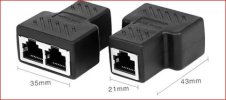We just received a pendant type PTZ camera (PTZ6C4G-45X) from Andy. I don't think these have an internal mic but have wiring for Line in and Line out. Installing it on a pole on our dock and wanted to install a microphone to listen to the birds and ocean. It would have to be pretty much salt spray resistant, even though I could mount it under the junction box or under the rain hood that I am adding to protect the camera itself from our somewhat incessant Pacific Northwest rain.
I don't see any external mics advertised on the Empiretech website and the specs on the camera aren't much help in identifying what type of microphone would work with the unit.
Thanks if anyone has any ideas on what mic would work!
Cheers
I don't see any external mics advertised on the Empiretech website and the specs on the camera aren't much help in identifying what type of microphone would work with the unit.
Thanks if anyone has any ideas on what mic would work!
Cheers


